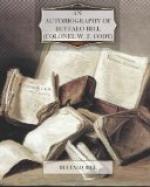The hunt took place twenty miles east of Sheridan. It had been well advertised, and there was a big “gallery.” An excursion party, whose members came chiefly from St. Louis and numbered nearly a hundred ladies and gentlemen, came on a special train to view the sport. Among them was my wife and my little daughter Arta, who had come to visit me for a time.
Buffaloes were plentiful. It had been agreed that we should go into the herd at the same time and make our “runs,” each man killing as many animals as possible. A referee followed each of us, horseback, and counted the buffaloes killed by each man. The excursionists and other spectators rode out to the hunting-grounds in wagons and on horseback, keeping well out of sight of the buffaloes, so as not to frighten them until the time came for us to dash into the herd. They were permitted to approach closely enough to see what was going on.
For the first “run” we were fortunate in getting good ground. Comstock was mounted on his favorite horse. I rode old Brigham. I felt confident that I had the advantage in two things: first, I had the best buffalo horse in the country; second, I was using what was known at the time as a needle-gun, a breech-loading Springfield rifle, caliber .50. This was “Lucretia,” the weapon of which I have already told you. Comstock’s Henry rifle, though it could fire more rapidly than mine, did not, I felt certain, carry powder and lead enough to equal my weapon in execution.
When the time came to go into the herd, Comstock and I dashed forward, followed by the referees. The animals separated. Comstock took the left bunch, I the right. My great forte in killing buffaloes was to get them circling by riding my horse at the head of the herd and shooting their leaders. Thus the brutes behind were crowded to the left, so that they were soon going round and round.
This particular morning the animals were very accommodating. I soon had them running in a beautiful circle. I dropped them thick and fast till I had killed thirty-eight, which finished my “run.”
Comstock began shooting at the rear of the buffaloes he was chasing, and they kept on in a straight line. He succeeded in killing twenty-three, but they were scattered over a distance of three miles. The animals I had shot lay close together.
Our St. Louis friends set out champagne when the result of the first run was announced. It proved a good drink on a Kansas prairie, and a buffalo hunter proved an excellent man to dispose of it.
While we were resting we espied another herd approaching. It was a small drove, but we prepared to make it serve our purpose. The buffaloes were cows and calves, quicker in their movements than the bulls. We charged in among them, and I got eighteen to Comstock’s fourteen.
Again the spectators approached, and once more the champagne went round. After a luncheon we resumed the hunt. Three miles distant we saw another herd. I was so far ahead of my competitor now that I thought I could afford to give an exhibition of my skill. Leaving my saddle and bridle behind, I rode, with my competitor, to windward of the buffaloes.




